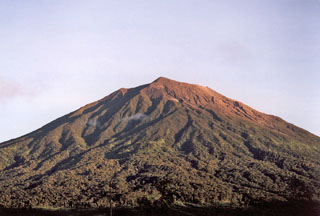Report on Kerinci (Indonesia) — October 1998
Bulletin of the Global Volcanism Network, vol. 23, no. 10 (October 1998)
Managing Editor: Richard Wunderman.
Kerinci (Indonesia) Rumbling, ash, and sulfur smell on 3 November
Please cite this report as:
Global Volcanism Program, 1998. Report on Kerinci (Indonesia) (Wunderman, R., ed.). Bulletin of the Global Volcanism Network, 23:10. Smithsonian Institution. https://doi.org/10.5479/si.GVP.BGVN199810-261170
Kerinci
Indonesia
1.697°S, 101.264°E; summit elev. 3800 m
All times are local (unless otherwise noted)
Increasing activity culminated in an eruption on 3 November. In the early afternoon the volcano rumbled three times and ash covered the nearby village of Palempok. Residents also noticed a strong sulfur smell. Rumbling was heard twice on 6 November by residents of Tangkil and Palempok. Unfortunately, the seismograph used to monitor the volcano had been inoperative since 3 November.
Geological Summary. Gunung Kerinci in central Sumatra forms Indonesia's highest volcano and is one of the most active in Sumatra. It is capped by an unvegetated young summit cone that was constructed NE of an older crater remnant. There is a deep 600-m-wide summit crater often partially filled by a small crater lake that lies on the NE crater floor, opposite the SW-rim summit. The massive 13 x 25 km wide volcano towers 2400-3300 m above surrounding plains and is elongated in a N-S direction. Frequently active, Kerinci has been the source of numerous moderate explosive eruptions since its first recorded eruption in 1838.
Information Contacts: R. Sukhyar, Volcanological Survey of Indonesia (VSI), Bandung, Indonesia (URL: http://www.vsi.esdm.go.id/).

